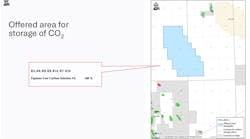Victor Schmidt
Houston
SEG developments
The Society of Exploration Geophysicists annual convention was well attended but less than organizers expected. This meant that the Salt Palace in Salt Lake City, Utah, buzzed with topical intensity rather than generic discussion. Of special note were developments in three areas: streamer equipment, mass storage, and attribute analysis.
The focus of seismic acquisition technology supplanted vessel design a year or two back after most service companies upgraded their fleets with high capacity vessels. Since that time, the industry's efforts have shifted to streamers. Streamer diameters have been reduced, positioning networks added, and traditional hydrophone sensors replaced by more compact and efficient units. Hydrophones are being replaced by accelerometers and soon may be replaced by light fiber, producing lighter, longer streamers.
Unit costs for storage continue to drop as capacities rise. Robotic tape systems are moving to denser media, and networked storage in many different configurations can now handle gigabits of survey data on demand.
Attribute analysis is becoming ever more sophisticated. Channel sands, reef complexes, and many other geologic structures are yielding their secrets to seismic attribute analysis. While the discernable geologic structures are still limited by the seismic frequencies recorded and the bin density, both have been improving as 3D surveys move to smaller bin sizes. These moves are increasing the need for better statics corrections, but the payoff is in the clearer images that result and in the potential reserves revealed. Improved understanding of rock properties and fluid boundaries are setting the stage for better oil recovery monitored with 4D seismic.
Visualization center
Schlumberger Oilfield Services opened its first collaborative virtual-reality center in the Middle East and Asia region. The Oasis iCenter is located in Abu Dhabi, U.A.E., providing a secure networked facility for technical experts and asset team members to collaborate.
The new facility offers a three-channel, passive stereo, curved screen, back-projected visualization package powered by Inside Reality software. It is the sixth in a series of iCenters that Schlumberger has deployed globally.
Survey activity
Geophysical survey activity has been steady but light this year compared to earlier periods. Recently, several large projects were completed:
•WesternGeco completed a 5,000-km 2D survey for Sonatrach over blocks 143, 144, and 145 offshore Algeria. A new licensing round is expected next year.
•Caspian Geophysical, the joint venture between WesternGeco and the State Oil Co. of Azerbaijan Republic, finished a 3D/4C survey over Azerbaijan International Operating Co.'s Azeri field, operated by BP. In addition, BP awarded Caspian Geophysical a second contract for a 3D/4C seismic survey over Gunashli field's deepwater portion.
•TGS-Nopec finished a 15,400-sq-km pre-stack depth migration project in the Mississippi Canyon area of the Gulf of Mexico.
•The CGG Mistral completed a 1,750-sq-km 3D survey off the west coast of Morocco. The vessel was recently reconfigured with eight 6,000-m Solid Seal streamers from Sercel.
TECHNOLOGY
Downhole monitoring
Sabeus Sensor Systems launched the Light-Sense 3C pressure-temperature-vibration sen-sing system and LightSense 400 real-time, distributed, temperature-sensing system. Each is intended for permanent downhole installation in wells to 12 km drilled depth. Both systems utilize a new type of fiber-optic sensor using "fiber Bragg grating." The sensors will last for over 10 years of service in the most extreme downhole environments.
Wave equation
CGG launched WaveVista and GeoVista2. WaveVista is a wave equation depth imaging service, which complements the release of GeoVista2, a Kirchhoff depth imaging software.
4D tools
Landmark Graphics of Halliburton and 4th Wave Imaging released ProMAX 4D, a suite of processing technologies that improve 4D seismic images. The software allows more accurate interpretation of fluid flow and pressure changes in oil and gas reservoirs.
PC clusters
ModViz released Renderizer Visual Cluster Management software, which enables off-the-shelf PCs arrayed in Linux clusters to produce high-end, real-time graphics similar to those from more expensive visualization solutions.
EXPLORATION
Indonesian surveys
TGS-Nopec began its Circum Makassar (CM-02) survey in the Makassar Straits of Indonesia. This new 2D multiclient survey will create 4,200 km of non-exclusive seismic in deep water beyond the Mahakam Delta. The survey is a joint venture between TGS-Nopec and WesternGeco and was undertaken in cooperation with the Indonesian Directorate General of Oil and Gas (Migas). The data from all the company's programs are being prepared for a licensing round in late 2003.
CGG will shoot a 3D seismic program for BP in Indonesia. The company will gather a series of ocean bottom cable/transition zone/land surveys along the Java Sea coast beginning with a 300 sq km OBC survey followed by a 200 sq km transition zone survey. BP has an option to add two more 3D surveys.
African survey
American International Exploration Group began shooting a 3,000-km 2D survey over Vanco's Cape Three Points deep license off-shore Ghana, West Africa. The Nan Hai 502 seismic vessel is shooting the survey in water depths of 1,500 to 2,500 m.
Brazil survey
CGG will shoot a 3D survey for Petrobras off Brazil's north coast. The survey will cover 2,620 sq km over blocks BM-CE-1 and BM-CE-2 in the Bacia de Ceara et Potiguar and block BM BAR-1 over the Bacia de Barreirinhas. The blocks are an unexplored basin and will be gathered by the CGG Harmattan in the first half of 2003.




